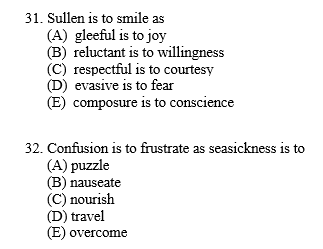
SSAT: How to Master the Verbal Section
SSAT Verbal Section
The Secondary School Admissions Test (SSAT) is one of the most popular private school admissions test for students entering middle school or high school, making it an essential test for your child to master.
The SSAT test follows the following format:

The Verbal section is one of the main scored sections of the SSAT, varying in difficulty level according to your child’s grade group.
This section is often one of the most challenging ones for students. It requires students to identify synonyms and interpret analogies, and demands a high level of vocabulary and critical thinking skills. Many students who prepare for the SSAT can start to feel stuck in the same Verbal score range.
That’s why MEK Review is here to help!
In this article, we’ll show you:
- What to expect on the SSAT Verbal section
- Common mistakes students and parents make when trying to prepare
- How your child can drastically improve their score
Let’s get started!
What to Expect for the SSAT Verbal Section
The SSAT Verbal section consists of:
- 60 questions
- 5 answer choices
- 30 synonyms
- 30 analogies
All within a 30-minute time limit!
The first 30 questions presents a word and then 5 possible synonyms for the word.
For example:

The student must be able to identify the given word’s meaning and then pair it with the closest synonym.
For instance, in question 1 of the above example, VIVID is an adjective that describes something that “produces a powerful or clear image to the mind”. Therefore the answer is (D), striking, as this is an adjective that means “noticeable” or “eye-catching” and is the closest match to vivid.
The last 30 questions gives students the first half of an analogy pair (or sometimes the first 3/4 of an analogy) and then 5 choices to complete the analogy:

Here a student must identify the meaning of the words, understand their relationship to each other, and then select the word(s) that best mirrors the same relationship. It requires higher-level reasoning skills.
For instance, in question 32 of the above example, confusion often causes someone to become frustrated. Similarly, seasickness often causes nausea. Therefore, the answer is (B), nauseate.
Why Students Struggle
Both the synonym and the analogy type questions in the SSAT’s Verbal section require an above-grade level vocabulary and include many words that the typical student will not encounter in the classroom.
Furthermore, students do not often encounter analogies at school. Generally they feel uncomfortable and even intimidated by analogies. They are unfamiliar with the different analogy types and the logical process that is required to gain the right answer.
For both reasons, students MUST spend time preparing for the test outside of the classroom if they want to do well.
Common Mistakes in Preparation
Once your child begins preparation for the SSAT Verbal section, avoid the following common mistakes made by both parents and students:
Mistake #1: Not Beginning Prep Early Enough
To see significant improvements on your child’s SSAT score, you need to plan for 3-6 months of preparation time.
Why?
To do well, students need time to build their vocabulary bank and master analogy types. This requires time – more time than parents usually estimate!
Students can quickly familiarize themselves with the test format by taking a few practice tests. However, each test has different words in the question and answer choices, so students must spend time studying and expanding their vocabulary. To truly expand their vocabulary, they must give themselves plenty of time to create and execute a strategic study plan.
Cramming at the last minute will not work. There are too many words they need to know.
For students who speak English as their second language and/or who don’t hear English spoken at home, it will be even more important for them to spend time boosting their vocabulary bank.
On the other hand, students who are avid readers may have a head start as books are a great way for young learners to learn new words in context. However, they will still need focused test preparation.
Mistake #2: Frustration Over Scores
Because it takes time to build up a vocabulary, SSAT Verbal score improvement is not a linear progression. Even in intensive test prep, students will experience periods of being “stuck” in a certain score range.
Often, as students become more familiar with analogy types, they will see an initial leap in score, but then plateau to a certain level for a few weeks.
The key is to not become frustrated.
Score improvements will come in jumps from range to range. A student will jump into a new score range or percentile ranking, stay there for a few weeks, and then jump again.
As long as your child is diligently studying and building up knowledge, his or her score will keep improving.
Mistake #3: Taking Only Practice Tests
Taking full-length practice tests is essential to boosting your child’s mental endurance, test-taking skills, time management, and overall score.
However, for the SSAT Verbal section, this routine will not be enough to bring a student’s score to maximum potential.
They need to spend time apart from the test studying new words, learning common prefixes, suffixes, and root words, as well as identifying analogy types.
Mistake #4: Studying Through Memorization
Even parents and students who do come up with a study plan, often make the mistake of trying to memorize a long list of words.
This is not effective or efficient.
While learning the definitions of new words is important, trying to memorize definitions alone will not help build a vast and elevated vocabulary. In order for students to really remember and become comfortable with a word, they have to make that word part of their everyday vernacular.
So in addition to learning the definition of a word, students need to practice using that word, writing with the word, seeing the word in different contexts, learning synonyms for the word, and understanding any common prefix, suffix, or roots used in the word.
With this thorough way of fully learning, the word can truly become part of students’ long-term memory. Otherwise, students will often memorize 20 words one week, but quickly forget them the next.
How to Prepare for the SSAT Verbal Section
So now that you know what not to do, here are 5 tips for helping your child prepare!
Tip #1: Boost Test-taking Strategy
No matter how much students prepares, they may still encounter words or analogies they don’t know.
Therefore, it’s important for them to practice good time management and test-taking skills by skipping questions they’re not sure about, answering those they are, and returning to the rest with their remaining time. Remind your child to always answer the easier questions first!
The SSAT does deduct points for wrong answers, so have your child practice choosing which questions to answer and which to leave blank. For instance, if your child has narrowed it down to 2 answer choices, she should go ahead and answer. However, if she can’t eliminate any answer choices, she should leave it unanswered.
Tip #2: Study Prefixes, Suffixes, and Root Words
Even if your child comes across a word he doesn’t know, if he is familiar with the prefix, suffix, and root of the word, this can be a big clue to the meaning of the word. It may even lead him to the right answer.
Here are a few sites that you and your child can use as a free resource:
Tip #3: Vary Vocabulary Studying
Use a variety of methods to help your child study vocabulary. Simply switch up how she is studying the words to keep her engaged. As a bonus, it can help her understand the word on different levels.
Here are a few suggestions for your child:
Quizlet: Use the free website Quizlet to make online flashcards. It’s easy and fun to use.
Traditional Flashcard: Have your child make flashcards, so he can pack them in his backpack and pull them out whenever he has the chance. He may be waiting for the bus, grocery shopping with you, or in the car and have time to study even for 10 minutes. This will make studying a part of his daily routine.
Example Sentences: Have your child write detailed sentences with the word that showcases the meaning of the word. The more specific and even quirky the sentence, the more likely she is to remember.
Google Images: Google the word with your child and hit the image option. Some kids are visual learners, and seeing pictures and cartoons of people smiling, shaking hands, or linking arms may help your child remember more clearly that affable means “friendly and warm.”
YouTube Search: Your child can also search words on YouTube and come across a clip of someone using this word in context. This will stick out more in his memory and help him understand how the word is used.
Merriam Webster Online: Have your child look the word up on Merriam Webster’s online dictionary The website doesn’t just give the definition and synonyms of a word. It also gives a brief explanation of the history and roots of the word. Most importantly, it pulls from all over the web to provide recent examples of the word being used in an article, so your child can see how the word is used in newspaper articles, blogs, and magazines.
Write a Story: Have your child take 5-10 vocabulary words and write a story using those words. The mind is not great at remembering raw information such as 10 new definitions, but it’s extremely good at recalling stories. By using the words in a story, your child is much more likely to recall context and hints around the definition of the word, versus a dry, dictionary definition of a word.
Group Synonyms Together: Have your child group new words together in groups of synonyms. Associating words together will cut down on what your child needs to remember and prepares him or her specifically for the SSAT Verbal section format. For instance, if they know that amenable, docile, and acquiescent are all synonyms, then instead of memorizing 3 separate definitions, they can remember that all three adjectives describe someone who is “ready to submit, obey, or go along with something”.
To sum it up, go beyond ineffective memorization to make new words a part of your child’s larger and permanent vocabulary.
Tip#4: Learn and Practice Analogy Types
Your child should become familiar with analogy types, so they can more easily identify the relationship between any two given words and select the appropriate match.
Here are the 9 most common analogy types in the SSAT Verbal section:
- Synonyms: Gregarious is to Social as Shy is to Introverted
- Antonyms: Awkward is to Graceful as Choleric is to Sanguine
- Part to Whole: Hand is to Human as Paw is to Dog
- Degree/Extremes: Rain is to Flood as Wind is to Hurricane
- Actor/Action/Object: Doctor is to Heal as Architect is to Build
- Characteristic of: Mirror is to Smooth as Mountain is to Tall
- Category & Example: Calculus is to Mathematics as Judaism is to Religion
- Cause & Effect: Nightmare is to Fear as Drama is to Catharsis
- Association: Jury is to Court as Textbook is to School
Knowing these 9 types of analogies will help students avoid common mistakes. For instance, in the “part to whole” example, a student who doesn’t recognize “hand is to human” as a “part to whole” relationship, may select a misleading answer choice that states “arm is to neck” as these are also human body parts.
However, by realizing that it’s a “part to whole” relationship, your child will be on the lookout for the most similar relationship and eliminate a choice like “arm is to neck”, as the arm is not part of the neck.
Tip #5: Create a Solid Study Plan
The most important aspect of test preparation is to have a set plan that helps your child study steadily and consistently throughout the months leading up to the test.
He or she needs to have a routine in order to have plenty of time, structure, and practice to prepare.
Putting It All Together
To help your child design and follow an effective, proven study plan, use MEK Review!
Using our proven timeline, we start our students’ SSAT preparation in the summer through our Exam Prep 8 course for incoming 8th graders and MEK Learning Circles for our younger students. Both programs build students’ vocabulary, analogy mastery, and test knowledge through expert teachers, proven strategies, and SSAT-aligned homework and quizzes.
We also show students how to create a study plan for each week.
During the Fall, our students transition into more intensive SSAT prep through our group classes or one-on-one private tutoring. Students take weekly full-length tests and learn test-taking techniques, while still expanding their vocabulary bank.
Our program helps students score in the 90th percentile of test-takers or higher!
Call 855-346-1410 or contact us today to register your child or receive more information.
We look forward to hearing from you!



